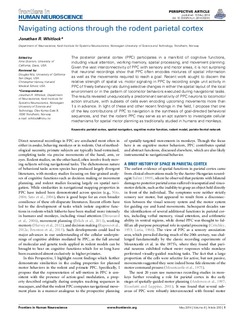| dc.contributor.author | Whitlock, Jonathan | |
| dc.date.accessioned | 2015-09-30T08:24:39Z | |
| dc.date.accessioned | 2016-01-21T15:59:56Z | |
| dc.date.available | 2015-09-30T08:24:39Z | |
| dc.date.available | 2016-01-21T15:59:56Z | |
| dc.date.issued | 2014 | |
| dc.identifier.citation | Frontiers in Human Neuroscience 2014, 8(MAY) | nb_NO |
| dc.identifier.issn | 1662-5161 | |
| dc.identifier.uri | http://hdl.handle.net/11250/2374496 | |
| dc.description.abstract | The posterior parietal cortex (PPC) participates in a manifold of cognitive functions, including visual attention, working memory, spatial processing, and movement planning. Given the vast interconnectivity of PPC with sensory and motor areas, it is not surprising that neuronal recordings show that PPC often encodes mixtures of spatial information as well as the movements required to reach a goal. Recent work sought to discern the relative strength of spatial vs. motor signaling in PPC by recording single unit activity in PPC of freely behaving rats during selective changes in either the spatial layout of the local environment or in the pattern of locomotor behaviors executed during navigational tasks. The results revealed unequivocally a predominant sensitivity of PPC neurons to locomotor action structure, with subsets of cells even encoding upcoming movements more than 1 s in advance. In light of these and other recent findings in the field, I propose that one of the key contributions of PPC to navigation is the synthesis of goal-directed behavioral sequences, and that the rodent PPC may serve as an apt system to investigate cellular mechanisms for spatial motor planning as traditionally studied in humans and monkeys. | nb_NO |
| dc.language.iso | eng | nb_NO |
| dc.publisher | Frontiers | nb_NO |
| dc.title | Navigating actions through the rodent parietal cortex | nb_NO |
| dc.type | Journal article | nb_NO |
| dc.date.updated | 2015-09-30T08:24:39Z | |
| dc.source.journal | Frontiers in Human Neuroscience | nb_NO |
| dc.identifier.doi | 10.3389/fnhum.2014.00293 | |
| dc.identifier.cristin | 1156471 | |
| dc.description.localcode | © 2014 Whitlock. This is an open-access article distributed under the terms of the Creative Commons Attribution License (CC BY). The use, distribution or reproduction in other forums is permitted, provided the original author(s) or licensor are credited and that the original publication in this journal is cited, in accordance with accepted academic practice. No use, distribution or reproduction is permitted which does not comply with these terms. | nb_NO |
